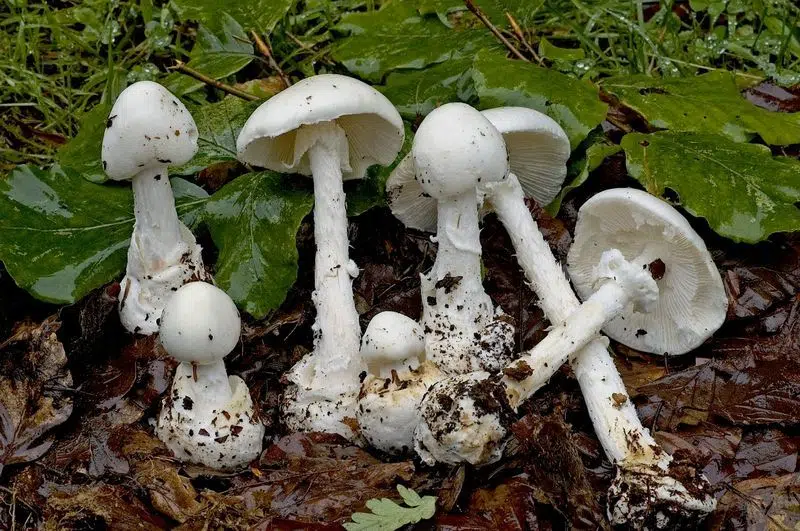
By Claudia Bashian-Victoroff
September is one of our favorite months in the Holden Forests & Gardens Soil Ecology lab. Why? Because it is National Mushroom Month. Many people celebrate National Mushroom Month by cooking and eating their favorite mushrooms. And we do too! But we also celebrate the month by appreciating all that fungi do for the natural world around us.
To kick off mushroom month, we’re doing something a little different for this week’s Science on Friday! Welcome to virtual mycology trivia!! Your questions are below. Over the next month you can submit your answers to my email cvictoroff@holdenfg.org with the subject “trivia”. On Friday September 30th, in the final installment of Science on Friday for the month of September we will announce the winner and the correct answers! Have fun and please refrain from using the google machine!
Without further ado:
Round 1: General mushroom trivia knowledge! In this round each correct answer will receive a point, with up to three possible bonus points!
- This genus of fungi is responsible for 95% of fatalities resulting from mushroom poisoning!
BONUS: This species alone (within the genus above) is responsible for 50% of all fatal mushroom poisonings!
- Fungi are often estimated to be the most diverse group of life, but only a small portion of their estimated species diversity has been discovered and described by science. Approximately how many species of fungi have scientists discovered?
- 7,000
- 70,000
- 150,000
- 500,000
BONUS: How many species of fungi are estimated to exist in the world? Closest guess will win the bonus point!
- This children’s author and illustrator published beloved picture books in the early 1900s, but her contributions to mycology were overlooked at the time likely due to her gender. Along with her many beautiful and scientifically accurate illustrations of fungi, this author contributed early observations of spore germination to the Linnean Society.
BONUS: The above author also wrote scientific theories on lichens. Lichens are composite organisms that exist due to the obligate symbiosis between what two types of organisms?
- Unlike plants, fungi do not rely on the sun for energy. Instead, fungi can live as decomposers, parasites, or mutualists (where both organisms benefit from the interaction). What key process do plants perform to absorb energy, which fungi do not?
BONUS: Shiitake mushrooms are common edible mushrooms (that we even grow here at Holden!). Shiitake’s grow on dead logs, meaning that they are…
- Decomposers
- Parasites
- Mutualists
Round 2: In this round I will replace some of the lyrics of common songs with a mushroom word or term. Your answer should be the name of the song and its artist.
Example: “Hey shroom don’t make it bad. Take a sad song and make it better. Remember to let her into your heart, then you can start to make it better.” (1968) Answer: Hey Jude by The Beatles
- “She’s so lucky, she’s a slime mold, but she cry, cry, cries in her lonely heart thinking, “if there’s nothing missing in my life then why do these tears come at night?”” (2000)
- “Laughing and a-running, hey, hey. Skipping and a-jumping in the misty morning fog with our hearts a-thumping, and you, my brown-spore print, you, my brown-spore print.” (1967)
- “Hey, I just met you and this is crazy, but here’s my number, so call me, hyphae.” (2011)
- “And feeling good was easy, when he sang the blues. You know feeling good was good enough for me; good enough for me and my Bolete” (1971)
Round 3: Photo round, do you know your mushrooms?
In this round I will accept the latin or the common name of the mushroom pictured. Unless noted, the latin should include both the genus and the species name. If the common name provided doesn’t match the common name in any common field guide, or if it incorrectly matches a different fungus, the answer will not be counted as correct.





Claudia Bashian-Victoroff, MS
Research Specialist
I am a fungal ecologist focused on connections between soil fungi and tree health. My research couples field collections with modern molecular identification methods to investigate ectomycorrhizal species diversity and function. As a research specialist in Dr. David Burke’s lab at the Holden Arboretum, I support research on soil ecology and forest pathology. Currently, I focus on the role of soil fungi in urban canopy restoration in Cleveland, OH. Trees growing in urbanized environments are subject to pressures such as habitat fragmentation, exposure to heavy metals, and soil compaction. Mycorrhizal fungi can enhance plant growth, disease resistance, and drought tolerance; therefore, it is necessary that we establish a better understanding of how these fungi might improve outcomes of urban restoration efforts. Beyond this, I enjoy discussing the importance of fungal research and conservation with diverse audiences through teaching, writing, and mentorship.













